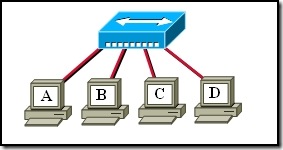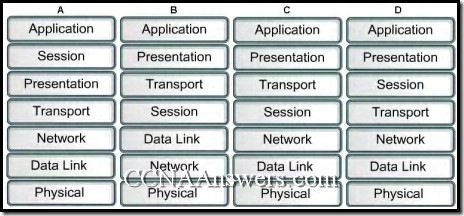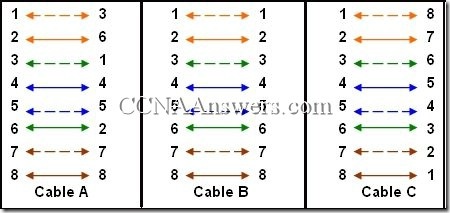CCNA 1 Module 9 V3.1 Answers
1.

Refer to the exhibit. Which two statements are correct in reference to the output shown? (Choose two.)
The LAN segment is subnetted to allow 254 subnets.
The DNS server for this host is on the same subnet as the host.
The host automatically obtained the IP addresses 192.168.1.100.
The host received the IP address from a DHCP-enabled device on the local LAN segment.
The host is assigned an address of 00-50-8D-F1-EA-8D by the administrator.
2.

Refer to the exhibit. The small office LAN shown in the exhibit may eventually be connected to the Internet. According to Cisco best practice, which IP network addresses should be used?
12.0.0.0
172.0.0.0
172.168.0.0
192.32.17.0
192.168.67.0
225.1.5.0
3. Which TCP/IP model layer supports both LAN and WAN technologies?
network access layer
internet layer
transport layer
application layer
4. What is the primary responsibility of the transport layer?
allows access to the network media
provides data representation and encoding
selects paths through the network for data to travel
defines end-to-end connectivity between host applications
5. Which IPv4 class provides the highest number of host addresses per network?
Class A
Class B
Class C
Class D
Class E
6. Which two statements correctly describe the IP address 127.0.0.1? (Choose two.)
It belongs to the Class A range of addresses.
It belongs to the Class B range of addresses.
It belongs to the Class C range of addresses.
It is reserved for loopback testing.
It is reserved for multicast group testing.
It is reserved for unicast testing.
7. Which IPv4 class of addresses provides the most networks?
Class A
Class B
Class C
Class D
Class E
8.

Refer to the exhibit. Which devices are recommended to have the IP addresses manually configured?
PC1 and PC2
all servers
only PC2 Laptop
all hosts and all servers
9. What is the purpose of a DHCP server on a network?
to resolve MAC addresses to IP addresses
to resolve IP addresses to MAC addresses
to resolve host names to IP addresses
to assign IP addresses dynamically to hosts
to assign a MAC address to a host
10.

Refer to the exhibit. What is the purpose of the Obtain an IP address automatically option shown in the exhibit?
to configure the computer to use ARP
to configure the computer to use DHCP
to configure the computer to use a routing protocol
to configure the computer with a statically assigned IP address
11. Why were private IP addresses developed?
to permit dynamic assignment of IP addresses
to permit the duplication of public IP addresses
to minimize the utilization of reserved IP addresses
to permit public IP addresses to be used in private networks
to address the issue of not enough available public IP addresses
12. Why is IP considered a best-effort protocol?
IP detects lost packets.
IP validates the content of the packets.
IP does not provide acknowledgment of the data delivery.
IP reorders the packet as they arrive at the destination host.
13. How many usable hosts are available given a Class C IP address with the default subnet mask?
254
255
256
510
511
512
14. What are two facts about how ARP resolves an IP address to a MAC address? (Choose two.)
The originating host dynamically issues an arp จCa command to obtain the destination MAC address.
The originating host broadcasts an ARP request packet and each host in a local network receives this packet.
The originating host dynamically issues an icmp echo request command to obtain the destination MAC address.
The host with the specified destination IP address sends an ARP reply packet containing its MAC address back to the originating host.
The host with the specified destination IP address sends an icmp echo reply packet to the originating host with its MAC address.
15. Which three addresses are considered to be private addresses? (Choose three.)
10.45.09.23
15.87.234.87
172.32.45.90
172.17.78.98
192.169.89.56
192.168.45.23
16.

Refer to the exhibit. Based on the information shown, which two statements are true? (Choose two.)
An ARP request must be used to obtain an address that is placed in the ARP table.
Frames from other hosts in the network to this host will use a destination address of 00-06-25-25-6e-5d.
The only remote locations that can be reached from this host are 192.168.1.97 and 192.168.1.254.
If a packet is sent to a network device other than 192.168.1.97 and 192.168.1.254, an ARP request must be used.
If the computer with the IP address of 192.168.1.94 sends a packet to the device with the IP address 192.168.1.97, no ARP request is required.
17. What is the network broadcast address for a Class C address of 192.168.32.0 with the default subnet mask?
192.168.0.0
192.168.0.255
192.168.32.0
192.168.32.254
192.168.32.255
18. Which statement accurately describes public IP addresses?
Public addresses cannot be used within a private network.
Public IP addresses must be unique across the entire Internet.
Public addresses can be duplicated only within a local network.
Public IP addresses are only required to be unique within the local network.
Network administrators are free to select any public addresses to use for network devices that access the Internet.
19. Which subnet mask would be assigned to the network address of 192.168.32.0 to provide 254 useable host addresses per subnetwork?
255.255.0.0
255.255.255.0
255.255.254.0
255.255.248.0
20. When a host has an empty ARP cache, what is the next step the host will take to find the destination MAC address of a remote host?
sends an ARP request as a unicast to the server
sends an ARP request as a unicast to the destination
sends an ARP request as a broadcast to all hosts in the local network
sends an ARP request as a unicast to the default gateway





Leave a Reply